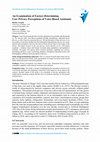Peer Reviewed Journal Articles by Brett J . L . Landry

International Journal of Management, Knowledge and Learning, 2023
Voice-based assistants have become ubiquitous in our homes and all around us. We interact with vo... more Voice-based assistants have become ubiquitous in our homes and all around us. We interact with voice-based assistants through smartphones, dedicated home devices, or other Internet-connected devices. The proliferation of these devices in our lives makes us question whether the data transmitted through these devices are secure and the role perception of privacy the users of these devices have in the usage of the device. This paper focuses on the user privacy issues specific to two voice-based assistants-Amazon Alexa and Google Assistant using quantitative and qualitative methods. The paper will answer three research questions regarding user privacy perceptions and how a user's technology adoption, smartphone operating system, and demographics influence their perception of privacy.
Study design/methodology/approach: This is a mixed research study where survey data was collected from faculty, staff, and students of a large University in the United States and professional connections globally.
Findings: Privacy perceptions vary based on user age, educational level, gender, smartphone adoption, and technical awareness and expertise.
Originality/value: This study is unique in highlighting the perception of privacy for voice-based assistants and assigning a numerical value based on survey data to the concern. Another feature of the study is its correlation of privacy perception with mobile phone operating systems and the level of technical expertise of voice-based assistant users.

Journal of Enterprise Information Management, Jul 2016
Purpose
– The purpose of this paper is to advocate for and provide guidance for the developmen... more Purpose
– The purpose of this paper is to advocate for and provide guidance for the development of a code of ethical conduct surrounding online privacy policies, including those concerning data mining. The hope is that this research generates thoughtful discussion on the issue of how to make data mining more effective for the business stakeholder while at the same time making it a process done in an ethical way that remains effective for the consumer. The recognition of the privacy rights of data mining subjects is paramount within this discussion.
Design/methodology/approach
– The authors derive foundational principles for ethical data mining. First, philosophical literature on moral principles is used as the theoretical foundation. Then, using existing frameworks, including legislation and regulations from a range of jurisdictions, a compilation of foundational principles was derived. This compilation was then evaluated and honed through the integration of stakeholder perspective and the assimilation of moral and philosophical precepts. Evaluating a sample of privacy policies hints that current practice does not meet the proposed principles, indicating a need for changes in the way data mining is performed.
Findings
– A comprehensive framework for the development a contemporary code of conduct and proposed ethical practices for online data mining was constructed.
Research limitations/implications
– This paper provides a configuration upon which a code of ethical conduct for performing data mining, tailored to meet the particular needs of any organization, can be designed.
Practical implications
– The implications of data mining, and a code of ethical conduct regulating it, are far-reaching. Implementation of such principles serve to improve consumer and stakeholder confidence, ensure the enduring compliance of data providers and the integrity of its collectors, and foster confidence in the security of data mining.
Originality/value
– Existing legal mandates alone are insufficient to properly regulate data mining, therefore supplemental reference to ethical considerations and stakeholder interest is required. The adoption of a functional code of general application is essential to address the increasing proliferation of apprehension regarding online privacy.

Communications of the Association for Information Systems, 2015
The prevalence of data mining by businesses and government organizations raises concerns among ma... more The prevalence of data mining by businesses and government organizations raises concerns among many individuals about the privacy of their personal data. We address this issue by offering a different perspective that reconciles the conflicting desires of businesses and consumers. We describe privacy, data mining, and their interaction in the larger context, identify the costs and benefits of the uses of data mining, and discuss potential stakeholders found at the intersection of the two subjects. To help synthesize our proposed code of ethical conduct, we examine existing codes of conduct and how they relate to the issue of privacy in the context of data mining with people, processes, and technology. Showing that a uniform code of ethical conduct for online privacy is feasible from both a managerial and ethical perspective, we provide an initial philosophical and principle synthesis that businesses and organizations can tailor for their own specific customers and needs. The developed code of ethical conduct respects consumers’ desire for privacy while allowing businesses to use data mining techniques to elicit information that benefits both the business and the consumer.
International Journal of Management, Knowledge and Learning, 2012
An increasingly popular business practice, data mining provides or the extraction of information ... more An increasingly popular business practice, data mining provides or the extraction of information from existing data to identify trends such as consumer purchasing practices and can foster greater efficiency in companies’ marketing efforts. There are corresponding costs associated with data mining, as well. The most difficult issue surrounding data mining is that of individual privacy rights and the costs associated with the potential alteration of ‘traditional’ privacy rights. This paper seeks to review basic definitional information on data mining and provide a strategy for companies’ successful, meaningful and ethical use of data mining as presented for meaningful knowledge
generation.
Information Resources Management Journal, 2011
An issue facing the manager of a small business is the use of cloud computing to meet the informa... more An issue facing the manager of a small business is the use of cloud computing to meet the information technology (IT) needs of the firm. These businesses typically have limited in-house IT capabilities and often outsource much of their IT. This paper discusses this rapidly evolving technology and provides a framework for businesses to decide on harnessing the power of cloud computing. It recommends the appropriate decision based on the way in which IT is currently used in the enterprise and future needs to meet competitive challenges. The potential cost savings, technology insurance from cloud computing, and security risks are discussed and factored into the decision.

Journal of Healthcare Management, 2010
The purpose of this prescriptive research is to help decision makers become better informed about... more The purpose of this prescriptive research is to help decision makers become better informed about three technologies emerging in the healthcare arena by providing a basic description of the technology and describing their current applications, future healthcare deployment, potential risks, and related managerial issues. Two of the technologies, radio frequency identification (RFID) and global positioning systems (GPS), are currently available to healthcare organizations and appear capable of decreasing cost but may require a significant initial investment and have disruptive potential. The third technology, nanotechnology, has limited current use but may revolutionize both the delivery of medicine and hospital infrastructure management. With cautious attention to managerial issues and meticulous attention to implementation details, healthcare organizations that can successfully navigate the coming technologically driven paradigm shifts will emerge more resilient organizations.

Information Security Journal: A Global Perspective, Aug 1, 2009
There is a common misconception that internal IP networks (intranets) are secure and that only ex... more There is a common misconception that internal IP networks (intranets) are secure and that only external networks such as the Internet and extranets are vulnerable and unsecured. The truth is that information on a network is not secure. With increases in network connectivity, the potential of bridging multiple networks on a single device, shared knowledge bases, and Web 2.0 integration of legacy applications, the problems are compounded. Traditional reliance on perimeter devices and security has proven to be ineffective in securing information in today’s highly connected environments. This lack of security on increasingly powerful handheld devices, which tap into our information assets, will inevitably lead to increased exposure for our enterprise networks. The very nature of devices being networked makes them vulnerable on an IP network to various attacks and spoofs. This paper proposes a new model to identify and examine threats to information assets from private, Internet, and enterprise sources.

International Journal of Management in Education, Mar 20, 2008
The educational system in the USA and around the world is changing as technology changes. Partial... more The educational system in the USA and around the world is changing as technology changes. Partially as a result of these changes in technology, there are a myriad of reasons for educational institutions of all kinds to offer less 'traditional' types of classes: online offerings. The decision to offer online classes rather than the more traditional classes can spring from a number of factors, including professors' and students' time constraints, the participants' physical location and even competition from the growing industry of 'online education'. The decision of individual schools and professors to offer online classes can be influenced by any or all of these and other reasons. However, the decision to offer online courses by some instructors is easy. Some may have previously participated in online or other forms of distance education classes. Others have participated in Web Enhanced Instruction (WEI) using Blackboard, eCollege or WebCT. But for some instructors, it is a daunting task to go from 'chalk and talk' to an online offering. This paper is meant to serve as a template for online course offerings. It will define the basic conceptual building blocks of online offerings. Additionally, this paper outlines the steps needed for the transformation from traditional to online course offerings and the associated issues.
International Journal of Services and Standards , Jan 1, 2007
Peer-to-Peer (P2P) applications are easy to use and pervasive at a variety of institutions, both ... more Peer-to-Peer (P2P) applications are easy to use and pervasive at a variety of institutions, both public and private, business, governmental and academic. They cause major problems with the networks upon which they are applied: viruses, worms, spyware and adware can cause crippling congestion of the network resources. Additionally, P2P file sharing applications typically violate the copyright law, as well as create legal liability through the concepts found in tort law. This paper will present very basic definitions of P2P technology, a review of the pervasiveness of the use of IP2PFS and a brief survey of legal measures designed to prevent illegal usage.

Decision Sciences Journal of Innovative Education, Jan 3, 2006
Web Enhanced Instruction (WEI) is not intended to replace the traditional classroom setting, but ... more Web Enhanced Instruction (WEI) is not intended to replace the traditional classroom setting, but rather to supplement the traditional lecture with course content that can be accessed from campus or the Internet. WEI has the potential to extend the boundaries of traditional classrooms by providing new opportunities for communication and interaction between students and the instructor. While the potential benefits of augmenting the traditional class with WEI have been recognized and discussed, what has remained largely unknown are student reactions to WEI as an addition to the traditional lecture. The Technology Acceptance Model (TAM) has been widely used in the Information Systems research to gather user reactions to information systems. The TAM examines users' perceptions of Usage, Usefulness, and Ease of Use. This research applied the TAM to the academic setting to measure student reactions to Blackboard, the WEI tool used in this study. Using several multivariate methods, results suggest that students (n = 692) found that the Blackboard elements which are associated with Course Content (Course Documents, Lectures, Student Tools, Announcements, and Quizzes) are used more often and are seen as more useful than those items that provide Course Support and communication (Discussion Board, External Web Sites, Faculty Information, and E-Mail).

British Journal of Educational …, Jan 1, 2006
The response and file exchange capabilities of web-enhanced instruction are focused by using web-... more The response and file exchange capabilities of web-enhanced instruction are focused by using web-based technologies to enhance the instructional setting for students to respond to materials provided by the instructor. The two specific features such as digital dropboxes and assignments, are considered for studying how the instructors can use the new assignments feature to increase interactivity. The digital dropbox function is intended to allow students to exchange files with the instructor and when used with group functions with each other. In the event the student has uploaded multiple files, then the instructor has to make sure that all of the files are downloaded for the assignment to be complete. The assignment is a relatively new feature in Blackboard that provides a technologically edged way of sharing information. It is possible to download all postings in one comprehensive compressed zip file with the assignment.
Journal of Educational Resources in Computing (JERIC), Jan 1, 2006
Disasters happen all the time; yet despite this, many organizations are caught unprepared or make... more Disasters happen all the time; yet despite this, many organizations are caught unprepared or make unrealistic assumptions. These factors create environments that will fail during a disaster. Most information technology (IT) curricula do not cover disaster recovery (DR) plans and strategies in depth. The unfortunate result is that most new computer systems are implemented without sufficient disaster recovery plans and testing. Courses on network security need to examine DR as a real threat and cover it as a core module. By dispelling the 10 common myths, organizations can better plan, develop, and test true DR plans.
International Journal of Services and Standards (IJSS), Jan 1, 2006
Peer-to-Peer (P2P) frequently transfer viruses and worms and, due to the sheer volume of traffic,... more Peer-to-Peer (P2P) frequently transfer viruses and worms and, due to the sheer volume of traffic, makes networks unusable. In addition, these applications are typically used illegally to transfer copyrighted materials. This paper provides an overview of the technical background related to P2P usage in universities. Further, a review of the responses already made by universities to Illegal P2P File Sharing (IP2PFS) will be set forth. This knowledge should alert academic and business users that the 'I' in IP2PFS means illegal and that there is an array of technical solutions available to prevent the illegal sharing of files.

Communications of the ACM, Jan 1, 2006
The last 20 years has been an era of tremendous technology infusion into business, education, and... more The last 20 years has been an era of tremendous technology infusion into business, education, and society. Virtually elements of society have been transformed by the use of technology. This change is important from an ethical perspective in terms of who IT workers are today and what their tasks are. Twenty years ago, IT workers were mainly limited to technical fields such as programming, data processing, server administration, and phone services. Today, IT workers are integrated into every department, function globally, and have access to a wealth of knowledge and information. It is unfortunate, however, that given the ubiquitous role of the IT professional, a uniform code of ethics does not yet exist for this segment of the workforce. IT professionals should, like those in all walks of life, behave ethically. In this article, we discuss basic principles found in both business and IT ethics, and we present a single code of ethics that applies to both arenas.

Journal of Organizational Change Management, Jan 1, 2005
Purpose
This paper reviews recent discussions in the information technology (IT) and management ... more Purpose
This paper reviews recent discussions in the information technology (IT) and management literatures in order to consider their implications and to make a series of predictions about organizational life in the coming e‐business era.
Design/methodology/approach
A wide variety of recent discussions, ranging from comments by political/governmental figures to scholarly reports in the academic literature, are reviewed to consider their implications for the structure and shape of jobs and the job market.
Findings
The review provides evidence that developments in IT suggest that significant levels of job loss will occur in routine jobs, coupled with a pronounced movement towards a job market of flexible, fluid groups of highly‐skilled, entrepreneurial, consultant‐like employees.
Practical implications
Should this transition take place, there will be little place in the coming workforce for low‐skilled employees and a significant decrease in the overall size of the workforce. The jobs which remain will be those, which by their very nature, are creative and cannot be automated. Managers, governmental policymakers, and the workforce, in general, will need to consider these implications.
Journal of Health and Human Services Administration, 2005
New information technologies place data on integrated information systems, and provide access via... more New information technologies place data on integrated information systems, and provide access via pervasive computing technologies. Pervasive computing puts computing power in the hands of all employees, available wherever it is needed. Integrated systems offer seamless data and process integration over diverse information systems. In this paper we look at the impact of these technologies on healthcare organizations in the future.

Journal of Business Ethics, Jan 1, 2005
The study of business ethics has led to the development of various principles that are the founda... more The study of business ethics has led to the development of various principles that are the foundation of good and ethical business practices. A corresponding study of Information Technology (IT) professionals’ ethics has led to the conclusion that good ethics in the development and uses of information technology correspond to the basic business principle that good ethics is good business. Ergo, good business ethics practiced by IT professionals is good IT ethics and vice versa. IT professionals are professionals in businesses; a difficulty presented to these professionals, however, is the number and diversity of codes of ethics to which they may be held. Considering the existence of several formalized codes of ethics prepared by various IT professionals’ associations, a more harmonized approach seems more reasonable. This paper attempts to present a review of the purpose of codes of ethics, the persons who should be covered by such codes and to organize codes of ethics for business in general and IT professionals in particular and to make the argument that, once again, good ethics is good business practice, regardless of the profession or occupation concerned.
book chapters by Brett J . L . Landry
… of research on information security and …, Jan 1, 2009
In the real world, security operates on a model of a physical guard who protects business premise... more In the real world, security operates on a model of a physical guard who protects business premises from unwanted intruders. In the real world, as threats in-crease, the human guards are supplemented with x-ray or other inspection technology to ensure that admitted persons do not bring ...
Conference Proceedings by Brett J . L . Landry
Proceedings of the Southwest Decision Sciences Institute, Mar 2023
In a strange way, in person, face-to-face meetings can be less productive than remote meetings on... more In a strange way, in person, face-to-face meetings can be less productive than remote meetings on Zoom and Microsoft Teams. Why? Traditional meetings involve groups of participants either in straight rows or gathered around tables where there is often a distance between the organizer/presenter and the audience. This paper describes an alternative approach using synchronous meeting tools for in-person meetings.











Uploads
Peer Reviewed Journal Articles by Brett J . L . Landry
Study design/methodology/approach: This is a mixed research study where survey data was collected from faculty, staff, and students of a large University in the United States and professional connections globally.
Findings: Privacy perceptions vary based on user age, educational level, gender, smartphone adoption, and technical awareness and expertise.
Originality/value: This study is unique in highlighting the perception of privacy for voice-based assistants and assigning a numerical value based on survey data to the concern. Another feature of the study is its correlation of privacy perception with mobile phone operating systems and the level of technical expertise of voice-based assistant users.
– The purpose of this paper is to advocate for and provide guidance for the development of a code of ethical conduct surrounding online privacy policies, including those concerning data mining. The hope is that this research generates thoughtful discussion on the issue of how to make data mining more effective for the business stakeholder while at the same time making it a process done in an ethical way that remains effective for the consumer. The recognition of the privacy rights of data mining subjects is paramount within this discussion.
Design/methodology/approach
– The authors derive foundational principles for ethical data mining. First, philosophical literature on moral principles is used as the theoretical foundation. Then, using existing frameworks, including legislation and regulations from a range of jurisdictions, a compilation of foundational principles was derived. This compilation was then evaluated and honed through the integration of stakeholder perspective and the assimilation of moral and philosophical precepts. Evaluating a sample of privacy policies hints that current practice does not meet the proposed principles, indicating a need for changes in the way data mining is performed.
Findings
– A comprehensive framework for the development a contemporary code of conduct and proposed ethical practices for online data mining was constructed.
Research limitations/implications
– This paper provides a configuration upon which a code of ethical conduct for performing data mining, tailored to meet the particular needs of any organization, can be designed.
Practical implications
– The implications of data mining, and a code of ethical conduct regulating it, are far-reaching. Implementation of such principles serve to improve consumer and stakeholder confidence, ensure the enduring compliance of data providers and the integrity of its collectors, and foster confidence in the security of data mining.
Originality/value
– Existing legal mandates alone are insufficient to properly regulate data mining, therefore supplemental reference to ethical considerations and stakeholder interest is required. The adoption of a functional code of general application is essential to address the increasing proliferation of apprehension regarding online privacy.
generation.
This paper reviews recent discussions in the information technology (IT) and management literatures in order to consider their implications and to make a series of predictions about organizational life in the coming e‐business era.
Design/methodology/approach
A wide variety of recent discussions, ranging from comments by political/governmental figures to scholarly reports in the academic literature, are reviewed to consider their implications for the structure and shape of jobs and the job market.
Findings
The review provides evidence that developments in IT suggest that significant levels of job loss will occur in routine jobs, coupled with a pronounced movement towards a job market of flexible, fluid groups of highly‐skilled, entrepreneurial, consultant‐like employees.
Practical implications
Should this transition take place, there will be little place in the coming workforce for low‐skilled employees and a significant decrease in the overall size of the workforce. The jobs which remain will be those, which by their very nature, are creative and cannot be automated. Managers, governmental policymakers, and the workforce, in general, will need to consider these implications.
book chapters by Brett J . L . Landry
Conference Proceedings by Brett J . L . Landry
Study design/methodology/approach: This is a mixed research study where survey data was collected from faculty, staff, and students of a large University in the United States and professional connections globally.
Findings: Privacy perceptions vary based on user age, educational level, gender, smartphone adoption, and technical awareness and expertise.
Originality/value: This study is unique in highlighting the perception of privacy for voice-based assistants and assigning a numerical value based on survey data to the concern. Another feature of the study is its correlation of privacy perception with mobile phone operating systems and the level of technical expertise of voice-based assistant users.
– The purpose of this paper is to advocate for and provide guidance for the development of a code of ethical conduct surrounding online privacy policies, including those concerning data mining. The hope is that this research generates thoughtful discussion on the issue of how to make data mining more effective for the business stakeholder while at the same time making it a process done in an ethical way that remains effective for the consumer. The recognition of the privacy rights of data mining subjects is paramount within this discussion.
Design/methodology/approach
– The authors derive foundational principles for ethical data mining. First, philosophical literature on moral principles is used as the theoretical foundation. Then, using existing frameworks, including legislation and regulations from a range of jurisdictions, a compilation of foundational principles was derived. This compilation was then evaluated and honed through the integration of stakeholder perspective and the assimilation of moral and philosophical precepts. Evaluating a sample of privacy policies hints that current practice does not meet the proposed principles, indicating a need for changes in the way data mining is performed.
Findings
– A comprehensive framework for the development a contemporary code of conduct and proposed ethical practices for online data mining was constructed.
Research limitations/implications
– This paper provides a configuration upon which a code of ethical conduct for performing data mining, tailored to meet the particular needs of any organization, can be designed.
Practical implications
– The implications of data mining, and a code of ethical conduct regulating it, are far-reaching. Implementation of such principles serve to improve consumer and stakeholder confidence, ensure the enduring compliance of data providers and the integrity of its collectors, and foster confidence in the security of data mining.
Originality/value
– Existing legal mandates alone are insufficient to properly regulate data mining, therefore supplemental reference to ethical considerations and stakeholder interest is required. The adoption of a functional code of general application is essential to address the increasing proliferation of apprehension regarding online privacy.
generation.
This paper reviews recent discussions in the information technology (IT) and management literatures in order to consider their implications and to make a series of predictions about organizational life in the coming e‐business era.
Design/methodology/approach
A wide variety of recent discussions, ranging from comments by political/governmental figures to scholarly reports in the academic literature, are reviewed to consider their implications for the structure and shape of jobs and the job market.
Findings
The review provides evidence that developments in IT suggest that significant levels of job loss will occur in routine jobs, coupled with a pronounced movement towards a job market of flexible, fluid groups of highly‐skilled, entrepreneurial, consultant‐like employees.
Practical implications
Should this transition take place, there will be little place in the coming workforce for low‐skilled employees and a significant decrease in the overall size of the workforce. The jobs which remain will be those, which by their very nature, are creative and cannot be automated. Managers, governmental policymakers, and the workforce, in general, will need to consider these implications.